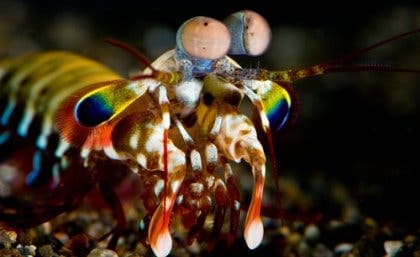
The Mantis Shrimp has some of the most amazing eyes in the animal kingdom. Researchers have shown that among others, it is able to detect a variety of cancers and visualize brain activity. Now, scientists from Queensland University have studied how the mantis shrimp’s eyes are superbly tuned to detect polarized light, and literally see cancers.
Professor Justin Marshall, from the Queensland Brain Institute at UQ, said cancerous tissue reflected polarized light differently to surrounding healthy tissue. Humans and most animals can’t see polarized light, but a small minority can:
“Humans can’t see this, but a mantis shrimp could walk up to it and hit it,” he said. “We see colour with hues and shades, and objects that contrast – a red apple in a green tree for example – but our research is revealing a number of animals that use polarized light to detect and discriminate between objects.”
Naturally, they wanted to see if they can somehow use this ability to actually detect cancer, and they developed a camera with the same visual capacities. The shrimp-eyed camera aimed at becoming an accurate, non-invasive and quick method of detecting cancer. It also has the ability to see the greatest range of color spectrum in the animal kingdom, being able to pick up 16 different colors (humans can pick up only 7).

“The camera that we’ve developed in close collaboration with US and UK scientists shoots video and could provide immediate feedback on detecting cancer and monitoring the activity of exposed nerve cells. “It converts the invisible messages into colours that our visual system is comfortable with.”
Theoretically, this could even allow smartphone cameras to be redesigned, so that people can monitor their own cancer.
Using devices which polarize light aren’t uncommon. The most notable technology is in polarized sun-glasses. Polarizing microscopes are also used intensively in studying minerals and rocks.
“Polarised sun-glasses are the most common technology we use every day, to reduce glare from water and wet roads,” he said. “They work because reflected light from these surfaces is polarised one way and the glasses are polarised the other.”, he adds. However, this is a totally different issue. “Even with polarising sunnies, the level of sensitivity needed to see neurons fire and reveal cancerous tissue is right at our current limit. Nature has coming up with elegant and efficient design principles, so we are combining the mantis shrimp’s millions of years of evolution – nature’s engineering – with our relatively few years of work with the technology.”
This is an excellent example of how different areas of science can come together and create something special which can actually make a difference in the future. Researchers from many different institutions are working on the issue, Washington University, the University of Maryland Baltimore County and the University of Bristol.
“The combined team is a good example of how interdisciplinary collaboration in science – between visual neuroscience, physics and electro-optical engineering – can provide really productive new approaches,” Professor Marshall said.
Journal Reference [open source]: York, T. ; Powell, S.B. ; Gao, S. ; Kahan, L. Bioinspired Polarization Imaging Sensors: From Circuits and Optics to Signal Processing Algorithms and Biomedical Applications. Proceedings of the IEEE (Volume:102 , Issue: 10 ). DOI 10.1109/JPROC.2014.2342537.


